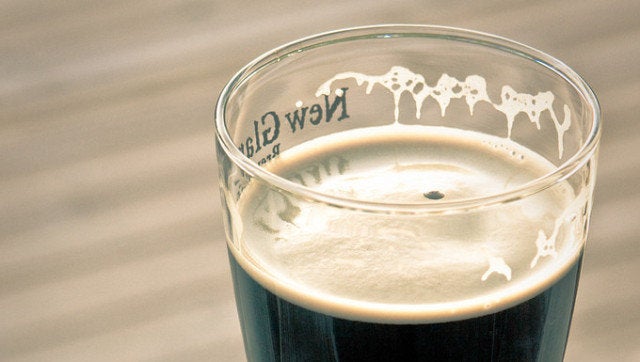
by John Verive, Guest Blogger for the Menuism Beer Blog
Photos by Nick Olejniczak and ***Karen
Today's beer drinkers demand more than the thin, yellow lagers from the giant multi-national breweries. They are better informed and have a more developed palate than ever before, and the craft beer industry has been happy to grow along with the surging ranks of beer fans. However, there are many pervasive myths and misconceptions about every aspect of beer that refuse to go away. Let's take a look at some of the most heinous falsities and set the record straight on dark beers, proper serving and storage temperature, and the damage done by years of beer advertisements.
Myth: You Can Judge a Beer By Its Color
There's no telling how these myths begun, but the idea that a dark beer is "heavier" than a light beer, or that dark beers are akin to a "meal in a glass" might be traced back to many people's first experience with a dark beer: Guinness Draught.
The idea that the heavy body of the stout will fill you up faster and add inches to your waistline -- the "liquid bread" effect -- is false. Guinness is, ounce-for-ounce, lighter than most other beers! A pint of the Irish ale clocks in at around 170 calories, while a 16-ounce serving of an American lager like Coors or Bud is around 200 calories. The confusion likely comes from the full and silky mouthfeel of the stout. The brewery uses oats in the brewing and nitrogen gas in the packaging of the stout, and both contribute to the rich and creamy impression that the beer leaves on your tongue.
Likewise, a beer's color has no correlation with its strength; Guinness is also only around 4% alcohol-by-volume. Dark lagers can be brewed just as easily as a dark ale; keep an eye out for Uinta's Baba Black Lager, a traditional German Schwarzbier, or even Guinness's own Black Lager for examples of lager beers that are light in body but not in color.
Myth: Warm Beer Is Bad Beer
The proper serving temperature of a beer is a well-discussed topic with little consensus. Influential beer writer Michael Jackson recommended a specific temperature range for every style of beer, and the big American brewers have been telling us that ice-cold beer is the best beer for decades. The truth, probably, lies somewhere in the middle. There are accepted guidelines for serving craft beers if you are interested, and American light lagers really are best consumed as cold as you can stand them, but personal preference is a better guideline than what the cicerones tell you. Experiment with different serving temperatures until you find your sweet spot for different styles. If you like the refreshing bite of a well-chilled IPA then go for it!
How about the idea that improper storage of beer will lead to the beer going bad? Maybe, but not likely. The beer certainly won't become "skunky" -- that phenomenon is created by the chemical reaction of UV light interacting with the bitter hops in the beer, and it's why the skunky flavor is more common in beer from a green or clear bottle. Extreme temperature fluctuations during storage -- swings of greater than 20 degrees -- will have a negative impact on the beer's flavor, but the effect is minor and slow to develop.
Cold stored beer will last longer, especially if it is a hoppy brew, but there is no real harm done to the beer if you take it out of the fridge and let it warm to room temperature, then chill it down again. It would take many cycles of cooling and warming to have an appreciable effect on the beer, and most beer has already experienced several cold-to-warm cycles in its journey from the brewery to your glass.
Unless you are cellaring one of the few types of beer that may improve with age, you should be more concerned about when you're drinking and not how you store it. With a few exceptions, beer is meant to be consumed fresh, and it should be treated that way.
Myth: Beer Ads Tell Us Something Useful
From the the post-prohibition onslaught of American brewery marketing beer ads to the "beer is good for you" Guinness ads of the 1940s, to our modern hyper-sexualized relentless TV spots, beer ads have a long history of spreading disinformation and propagating myths about the nobel beverage.
Miller claims their beer is "triple hop brewed," when nearly every modern style of beer calls for three hop additions during brewing. Likewise, there is no such thing as "hot filtered," so the claim that a beer is "cold filtered" is redundant and fairly meaningless.
As today's beer drinker's tastes and palates evolve and become more sophisticated, so too should his or her knowledge of the drink. Seek out the truth behind the brews and educate yourself on the finer points of craft beer, and you'll surely enjoy your next pint that much more. The Menuism Beer Blog and the archives of craftbeer.com are great places to start on your journey.
Related Links from the Menuism Beer Blog:
• 15 Awesome Craft Beers in a Can
• Warm Up With a Winter Beer
• A Guide to Belgian Beer Styles
Beer Myths That Won't Go Away originally published on the Menuism Beer Blog.
John Verive is a writer and craft beer enthusiast working to cultivate the beer scene in his hometown of Los Angeles with his website Beer of Tomorrow. He also covers the beer beat for the Los Angeles Times Daily Dish food blog and loves to find off-beat pairings of food and beer. You can follow John on Twitter at @octopushat and @beeroftomorrow.